Permeability Evolution of Porous Sandstone in the Initial Period of Oil Production: Comparison of Well Test and Coreflooding Data
Abstract
:1. Introduction
- the permeability determined during well testing takes into account the zonal and layered heterogeneity of the oil reservoirs;
- formation pressure change leads to formation deformation, fracture closure and separation of individual layers;
- during extraction, the core undergoes significant volumetric deformations and can no longer reflect natural conditions.
2. Permeability Evolution Based on the Analysis of Well Test Data
- narrowing of pores by increasing the effective pressure;
- deposition of organic and inorganic precipitations within pores;
- changes in relative phase permeability;
- migration of colloids.
- change in effective pressure in the observed wells did not exceed 5%, while the formation deformation should not be significant, which does not correspond to a decrease in permeability;
- deposition of organic and inorganic precipitations within pores did not occur because thermobaric conditions did not contribute to this. The temperature in the well does not change during production, and the bottomhole pressure in the well and in the reservoir does not drop below saturation pressure, so organic deposits and gas release are unlikely;
- scale precipitation is possible due to the interaction of incompatible waters. In our case, the water cut in the wells did not exceed 5%, so the effect of watered perforations is insignificant and cannot lead to large changes in permeability;
- there was no change in the relative phase permeability, since only oil enters the well under the selected conditions.
3. Permeability Evolution Based on the Coreflooding Data
3.1. Rock Samples and Procedure
3.2. Coreflooding Test Results and Analysis
3.3. CT Results and Analysis
- the increase in the crack opening mainly in the central part of the sample, probably due to the wedging action of a high pressure drop up to 4.3 MPa;
- the closing of cracks emerging on the surface of the sample due to the influence of internal wedging and external confining pressures;
- due to the relatively low resolution (20.1 μm), the analysis of the influence of the migration of particles and colloids with a size of up to 20 μm was not possible.
4. Discussion and Model Explanation
5. Conclusions
Author Contributions
Funding
Institutional Review Board Statement
Informed Consent Statement
Data Availability Statement
Conflicts of Interest
References
- Nur, A.; Byerlee, J.D. An exact effective stress law for elastic deformation of rock with fluids. J. Geophys. Res. Space Phys. 1971, 76, 6414–6419. [Google Scholar] [CrossRef]
- Li, M.; Bernabé, Y.; Xiao, W.-I.; Chen, Z.-Y.; Liu, Z.-Q. Effective pressure law for permeability of E-bei sandstones. J. Geophys. Res. Space Phys. 2009, 114, B07205. [Google Scholar] [CrossRef] [Green Version]
- Ghabezloo, S.; Sulem, J.; Guédon, S.; Martineau, F. Effective stress law for the permeability of a limestone. Int. J. Rock Mech. Min. Sci. 2009, 46, 297–306. [Google Scholar] [CrossRef] [Green Version]
- Sigal, R.F. The pressure dependence of permeability. Petrophys. SPWLA J. Form. Eval. Reserv. Descr. 2002, 43, 92–102. [Google Scholar]
- Kozhevnikov, E.; Riabokon, E.; Turbakov, M. A model of reservoir permeability evolution during oil production. Energies 2021, 14, 2695. [Google Scholar] [CrossRef]
- Kozhevnikov, E.V.; Turbakov, M.S.; Riabokon, E.P.; Poplygin, V.V. Effect of effective pressure on the permeability of rocks based on well testing results. Energies 2021, 14, 2306. [Google Scholar] [CrossRef]
- Pourciau, R.D.; Fisk, J.H.; Descant, F.J.; Waltman, B. Completion and Well Performance Results, Genesis Field, Deepwater Gulf of Mexico. SPE Drill. Complet. 2005, 20, 147–155. [Google Scholar] [CrossRef]
- Kwon, O.; Kronenberg, A.K.; Gangi, A.F.; Johnson, B. Permeability of Wilcox shale and its effective pressure law. J. Geophys. Res. Space Phys. 2001, 106, 19339–19353. [Google Scholar] [CrossRef]
- Zheng, J.; Zheng, L.; Liu, H.-H.; Ju, Y. Relationships between permeability, porosity and effective stress for low-permeability sedimentary rock. Int. J. Rock Mech. Min. Sci. 2015, 78, 304–318. [Google Scholar] [CrossRef] [Green Version]
- David, C.; Menendez, B.; Zhu, W.; Wong, T.F. Mechanical compaction, microstructures and permeability evolution in sandstones. Phys. Chem. Earth A 2001, 26, 45–51. [Google Scholar] [CrossRef]
- Zhang, Y.; Wang, L.; Li, H.; Zhang, Y.; Fu, G. Experimental study of the permeability of fractured sandstone under complex stress paths. Energy Sci. Eng. 2020, 8, 3217–3227. [Google Scholar] [CrossRef]
- Zhang, D.M.; Yang, Y.S.; Chu, Y.P.; Zhang, X.; Xue, Y.G. Influence of loading and unloading velocity of confining pressure on strength and permeability characteristics of crystalline sandstone. Results Phys. 2018, 9, 1363–1370. [Google Scholar] [CrossRef]
- Selvadurai, A.P.S.; Zhang, D.; Kang, Y. Permeability evolution in natural fractures and their potential influence on loss of productivity in ultra-deep gas reservoirs of the Tarim Basin, China. J. Nat. Gas Sci. Eng. 2018, 58, 162–177. [Google Scholar] [CrossRef]
- Mavko, G.; Jizba, D. Estimating grain-scale fluid effects on velocity dispersion in rocks. Geophysics 1991, 56, 1940–1949. [Google Scholar] [CrossRef]
- Liu, H.-H.; Rutqvist, J.; Berryman, J.G. On the relationship between stress and elastic strain for porous and fractured rock. Int. J. Rock Mech. Min. Sci. 2009, 46, 289–296. [Google Scholar] [CrossRef] [Green Version]
- Dong, J.-J.; Hsu, J.-Y.; Wu, W.-J.; Shimamoto, T.; Hung, J.-H.; Yeh, E.-C.; Wu, Y.-H.; Sone, H. Stress-dependence of the permeability and porosity of sandstone and shale from TCDP Hole-A. Int. J. Rock Mech. Min. Sci. 2010, 47, 1141–1157. [Google Scholar] [CrossRef]
- An, C.; Killough, J.; Xia, X. Investigating the effects of stress creep and effective stress coefficient on stress-dependent permeability measurements of shale rock. J. Pet. Sci. Eng. 2021, 198, 108155. [Google Scholar] [CrossRef]
- Pittman, E.D.; Larese, R.E. Compaction of Lithic Sands: Experimental Results and Applications (1). AAPG Bull. 1991, 75, 1279–1299. [Google Scholar] [CrossRef]
- Hu, C.; Agostini, F.; Skoczylas, F.; Jeannin, L.; Egermann, P.; Jia, Y. Transport property evolution during hydrostatic and triaxial compression of a high porosity sandstone. Eur. J. Environ. Civ. Eng. 2020, 1–14. [Google Scholar] [CrossRef]
- Hu, C.; Agostini, F.; Jia, Y. Porosity and Permeability Evolution with Deviatoric Stress of Reservoir Sandstone: Insights from Triaxial Compression Tests and In Situ Compression CT. Geofluids 2020, 2020, 6611079. [Google Scholar] [CrossRef]
- Li, X.; Chen, Y.F.; Wei, K.; Hu, R.; Yang, Z.B. A thresholdstresses-based permeability variation model for microcracked porous rocks. Eur. J. Environ. Civ. Eng. 2020, 24, 787–813. [Google Scholar] [CrossRef]
- Pimienta, L.; Quintal, B.; Caspari, E. Hydro-mechanical coupling in porous rocks: Hidden dependences to the microstructure? Geophys. J. Int. 2021, 224, 973–984. [Google Scholar] [CrossRef]
- Wang, C.; Wang, R.; Huo, Z.; Xie, E.; Dahlke, H.E. Colloid transport through soil and other porous media under transient flow conditions—A review. Wiley Interdiscip. Rev. Water 2020, 7, e1439. [Google Scholar] [CrossRef]
- Chen, W.; Han, Y.; Agostini, F.; Skoczylas, F.; Corbeel, D. Permeability of a Macro-Cracked Concrete Effect of Confining Pressure and Modelling. Materials 2021, 14, 862. [Google Scholar] [CrossRef]
- Mayr, S.I.; Stanchits, S.; Langenbruch, C.; Dresen, G.; Shapiro, S.A. Acoustic emission induced by pore-pressure changes in sandstone samples. Geophysics 2011, 76, MA21–MA32. [Google Scholar] [CrossRef]
- Pestman, B.J.; Van Munster, J.G. An acoustic emission study of damage development and stress-memory effects in sandstone. Int. J. Rock Mech. Min. Sci. Geomech. Abstr. 1996, 33, 585–593. [Google Scholar] [CrossRef]
- Yang, J.; Yin, Z.-Y.; Laouafa, F.; Hicher, P.-Y. Analysis of suffusion in cohesionless soils with randomly distributed porosity and fines content. Comput. Geotech. 2019, 111, 157–171. [Google Scholar] [CrossRef]
- Bedrikovetsky, P.; Siqueira, F.D.; Furtado, C.A.; Souza, A.L.S. Modified particle detachment model for colloidal transport in porous media. Transp. Porous. Med. 2011, 86, 353–383. [Google Scholar] [CrossRef]
- Gruesbeck, C.; Collins, R.E. Entrainment and deposition of fine particles in porous media. Soc. Pet. Eng. J. 1982, 22, 847–856. [Google Scholar] [CrossRef]
- Muecke, T.W. Formation fines and factors controlling their movement in porous media. J. Pet. Technol. 1979, 31, 144–150. [Google Scholar] [CrossRef]
- Khilar, K.C.; Fogler, H.S. Colloidally induced fines migration in porous media. Rev. Chem. Eng. 1987, 4, 41–108. [Google Scholar] [CrossRef]
- Parvan, A.; Jafari, S.; Rahnama, M.; Norouzi-Apourvari, S.; Raoof, A. Insight into particle detachment in clogging of porous media; a pore scale study using lattice Boltzmann method. Adv. Water Resour. 2021, 151, 103888. [Google Scholar] [CrossRef]
- Klimenko, L.S.; Maryshev, B.S. Numerical simulation of microchannel blockage by the random walk method. Chem. Eng. J. 2020, 381, 122644. [Google Scholar] [CrossRef]
- Frey, J.M.; Schmitz, P.; Dufreche, J.; Gohr Pinheiro, I. Particle deposition in porous media: Analysis of hydrodynamic and weak inertial effects. Transp. Porous Media 1999, 37, 25–54. [Google Scholar] [CrossRef]
- Borazjani, S.; Behr, A.; Genolet, L.; Van Der Net, A.; Bedrikovetsky, P. Effects of fines migration on low-salinity waterflooding: Analytical modelling. Transp. Porous. Med. 2017, 116, 213–249. [Google Scholar] [CrossRef]
- Yang, Y.; You, Z.; Siqueira, F.D.; Vaz, A.; Bedrikovetsky, P. Modelling of slow fines migration and formation damage during rate alteration. In Proceedings of the SPE Asia Pacific Oil & Gas Conference and Exhibition, Perth, Australia, 25–27 October 2016. [Google Scholar] [CrossRef]
- Ochi, J.; Vernoux, J.-F. Permeability decrease in sandstone reservoirs by fluid injection. J. Hydrol. 1998, 208, 237–248. [Google Scholar] [CrossRef]
- Chen, C.; Packman, A.I.; Gaillard, J.-F. Pore-scale analysis of permeability reduction resulting from colloid deposition. Geophys. Res. Lett. 2008, 35, L07404. [Google Scholar] [CrossRef]
- Sauret, A.; Somszor, K.; Villermaux, E.; Dressaire, E. Growth of clogs in parallel microchannels. Phys. Rev. Fluids 2018, 3, 104301. [Google Scholar] [CrossRef] [Green Version]
- Qiu, K.; Gherryo, Y.; Shatwan, M.; Fuller, J.; Martin, W. Fines migration evaluation in a mature field in Libya. In Proceedings of the SPE Asia Pacific Oil and Gas Conference and Exhibition, Perth, Australia, 20–22 October 2008. [Google Scholar] [CrossRef]
- Ramachandran, V.; Fogler, H.S. Plugging by hydrodynamic bridging during flow of stable colloidal particles within cylindrical pores. J. Fluid Mech. 1999, 385, 129–156. [Google Scholar] [CrossRef]
- Torkzaban, S.; Bradford, S.A.; Vanderzalm, J.L.; Patterson, B.M.; Harris, B.; Prommer, H. Colloid release and clogging in porous media: Effects of solution ionic strength and flow velocity. J. Contam. Hydrol. 2015, 181, 161–171. [Google Scholar] [CrossRef] [Green Version]
- Kozhevnikov, E.V.; Turbakov, M.S.; Gladkikh, E.A.; Riabokon, E.P.; Poplygin, V.V.; Guzev, M.A.; Qi, C.; Kunitskikh, A.A. Colloid Migration as a Reason for Porous Sandstone Permeability Degradation during Coreflooding. Energies 2022, 15, 2845. [Google Scholar] [CrossRef]
- Kozhevnikov, E.V.; Turbakov, M.S.; Gladkikh, E.A.; Riabokon, E.P.; Poplygin, V.V.; Guzev, M.A.; Qi, C.; Jing, H. Colloidal-induced permeability degradation assessment of porous media. Géotech. Lett. 2022, 12, 1–18. [Google Scholar] [CrossRef]
- Xiao, B.; Wang, W.; Zhang, X.; Long, G.; Fan, J.; Chen, H.; Deng, L. A novel fractal solution for permeability and Kozeny-Carman constant of fibrous porous media made up of solid particles and porous fibers. Powder Technol. 2019, 349, 92–98. [Google Scholar] [CrossRef]
- Liang, M.; Fu, C.; Xiao, B.; Luo, L.; Wang, Z. A fractal study for the effective electrolyte diffusion through charged porous media. Int. J. Heat Mass Transf. 2019, 137, 365–371. [Google Scholar] [CrossRef]


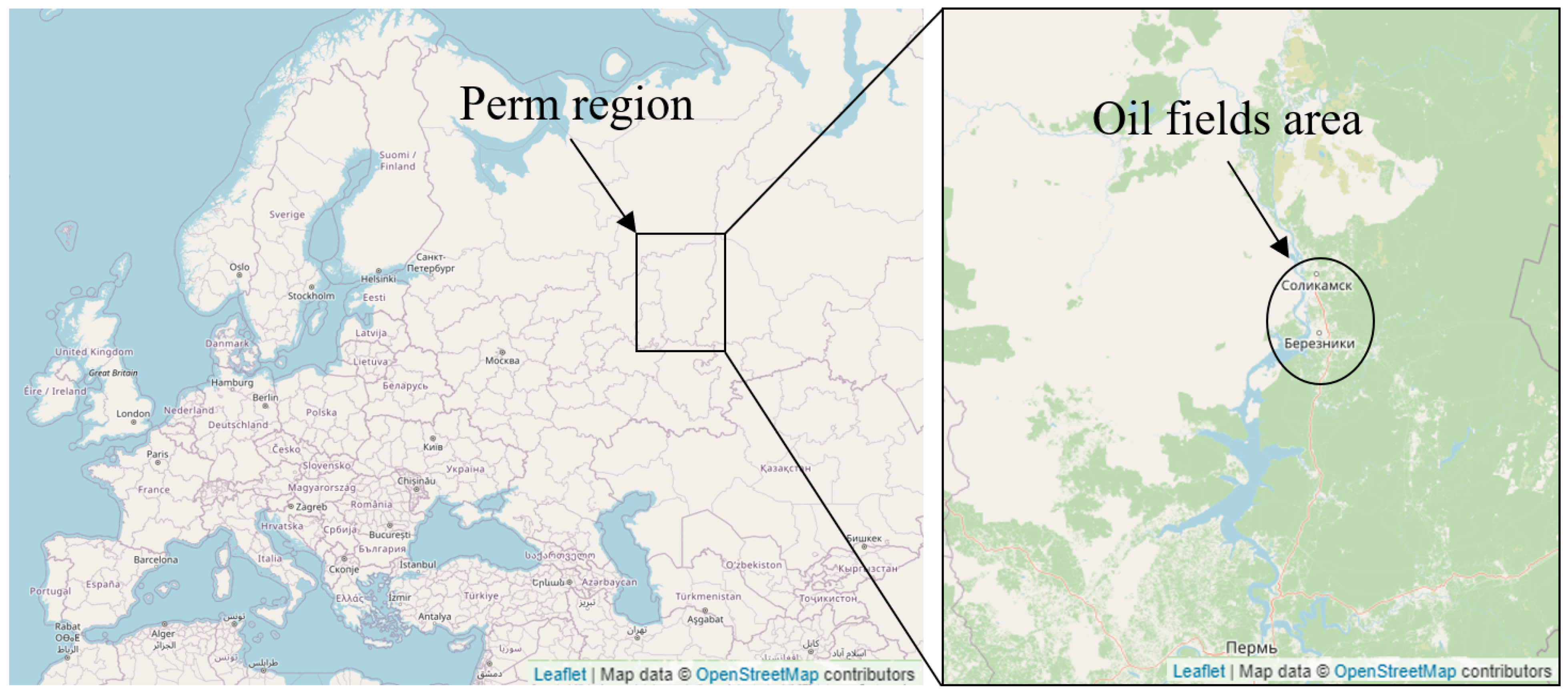

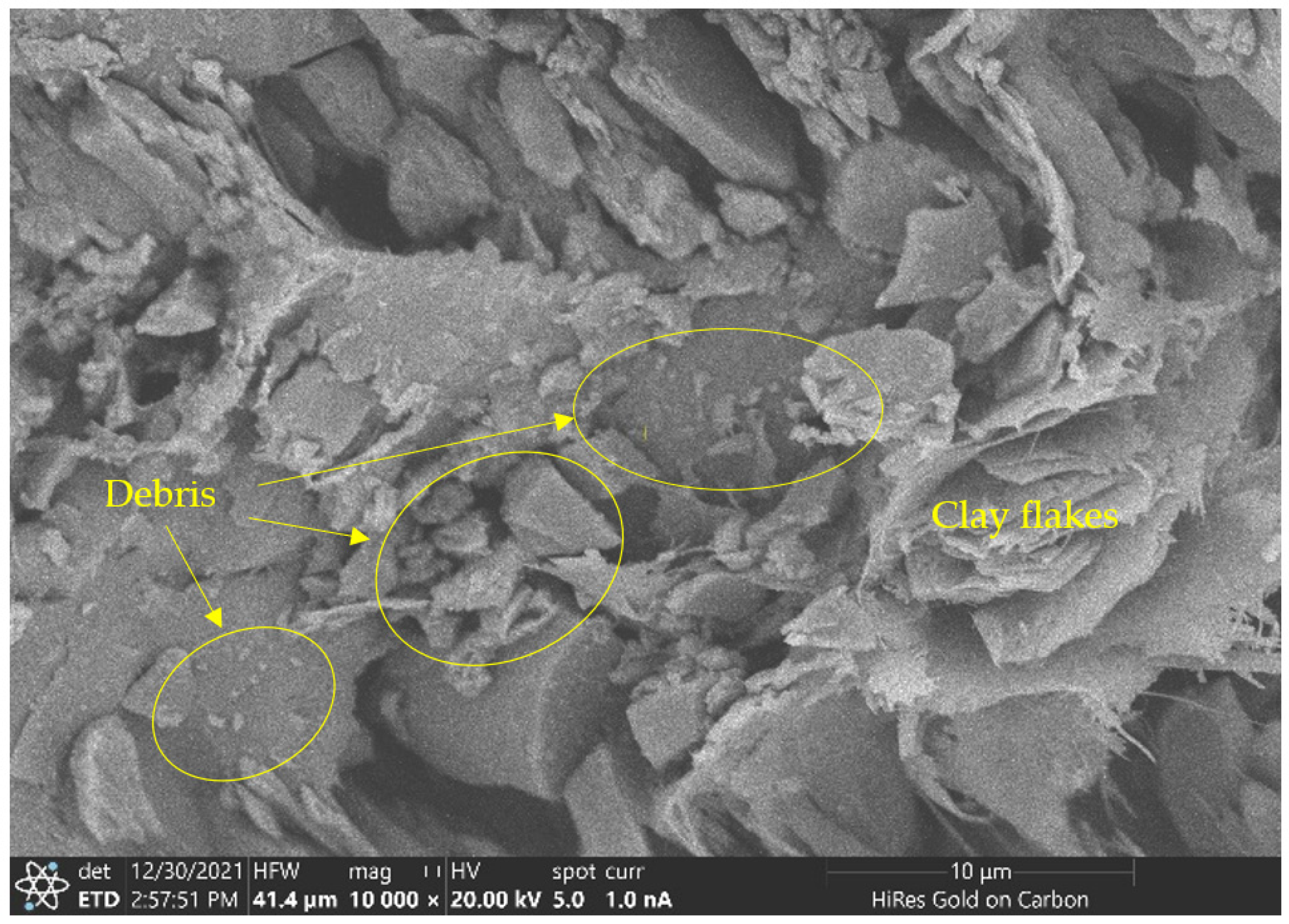
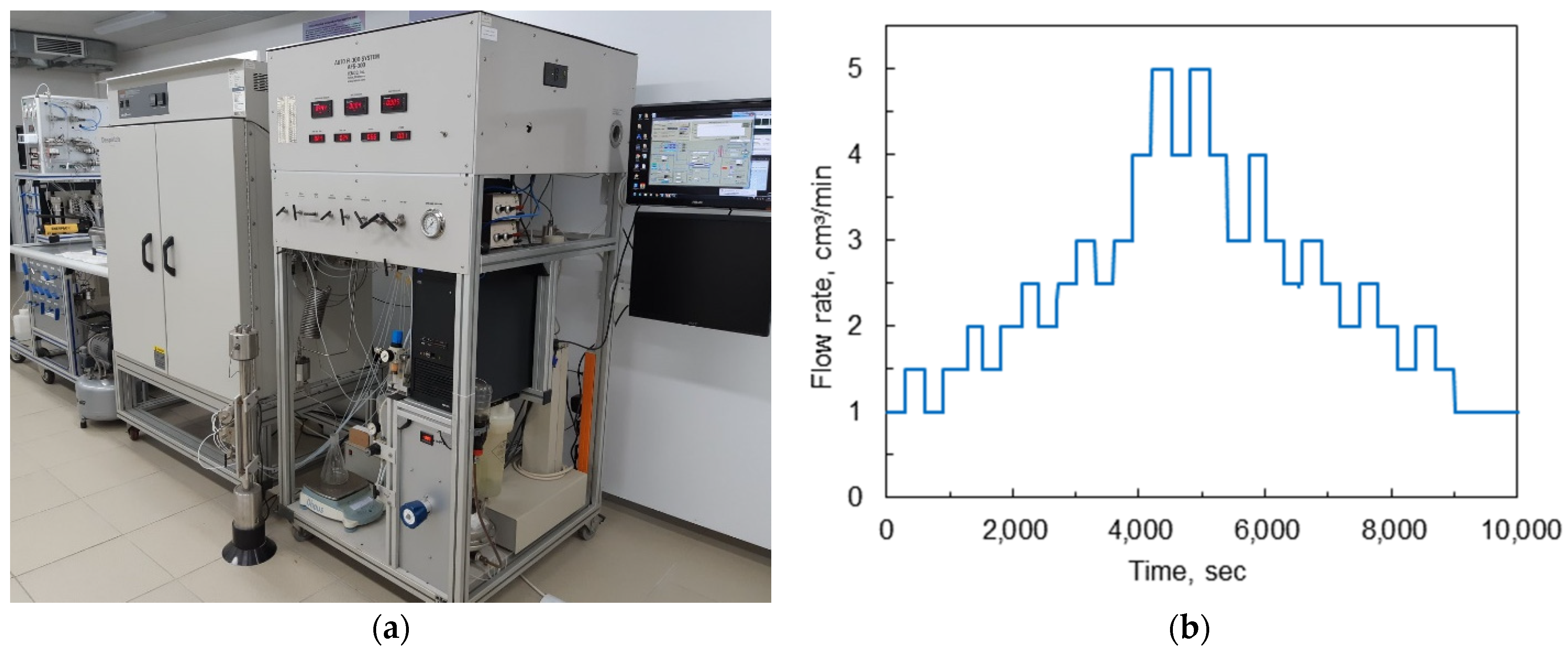
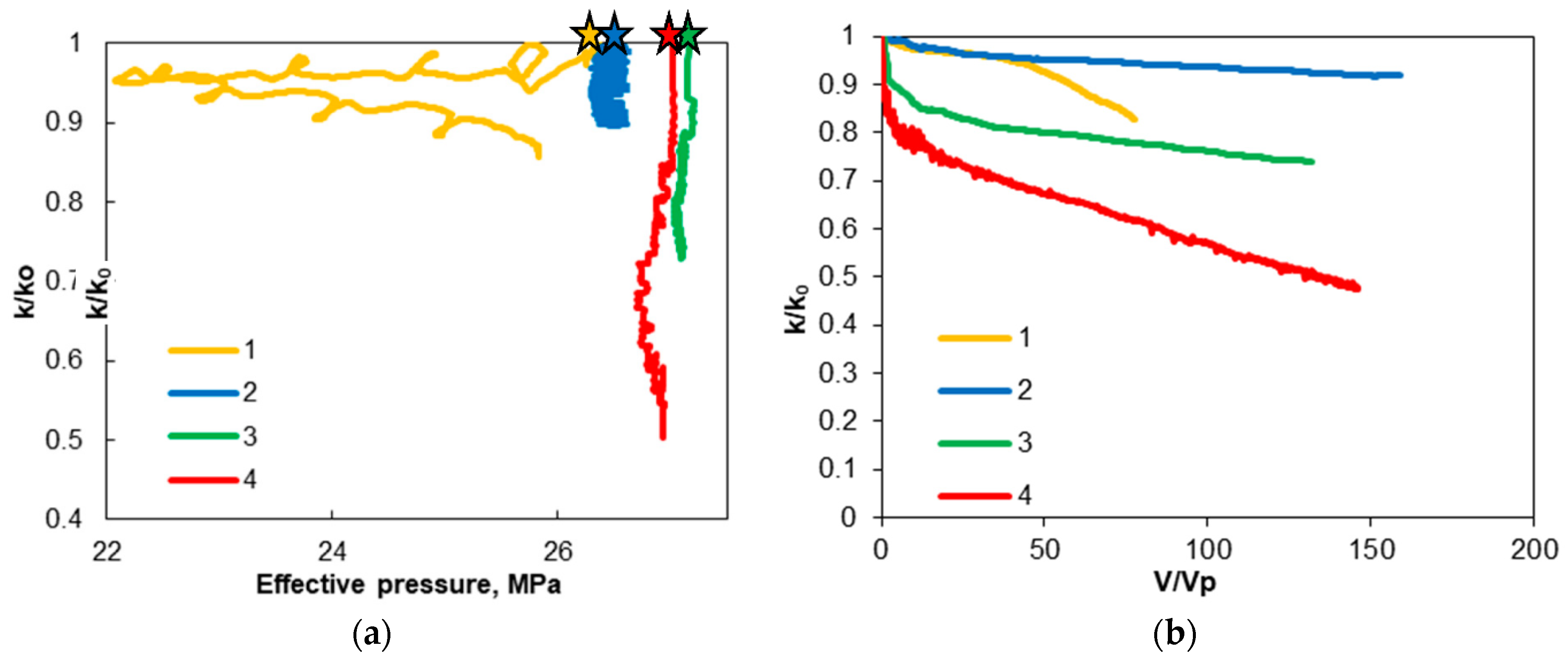
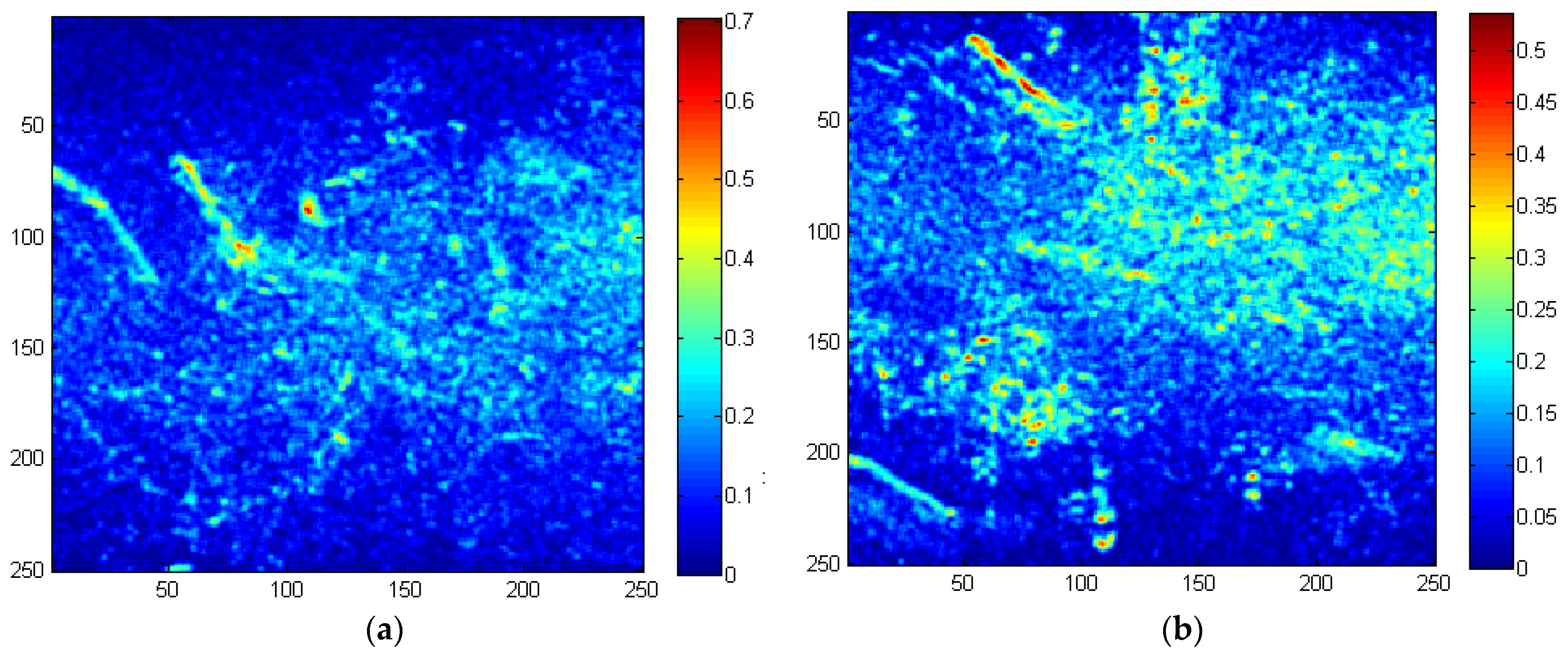
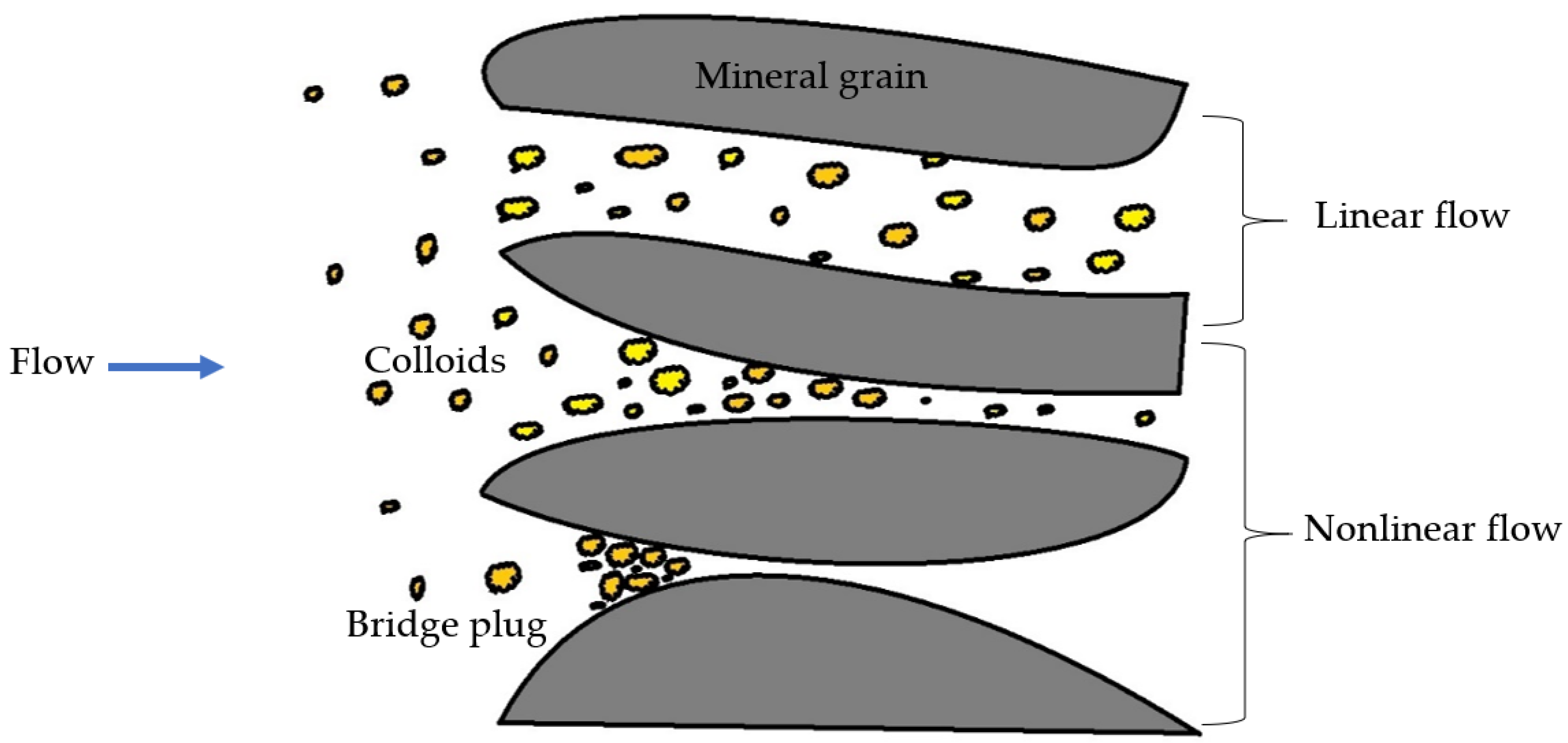

| Group | 1 | 2 | 3 |
|---|---|---|---|
| Number of wells | 5 | 8 | 7 |
| ko, D | 0.04–0.1 | 0.04–2.0 | 0.09–0.13 |
| Maximum productivity, m3/(d·m·MPa) | 0.18–1.75 | 0.21–9.5 | 0.9–1.1 |
| ΔP, MPa | 4.5–7.5 | 0.67–5.5 | 7.6–8.1 |
| a | 0.88 | 0.69 | 0.61 |
| b | −2.31 | −0.6 | −0.39 |
| c | −0.015 | −0.008 | 0.0001 |
| d | 0.092 | 0.137 | 0.267 |
| R2 | 0.98 | 0.92 | 0.78 |
| Sample № | 1 | 2 | 3 | 4 |
|---|---|---|---|---|
| Absolute permeability, D | 0.9 | 47.27 | 52.12 | 27.97 |
| Porosity, % | 8.2 | 10.31 | 8.45 | 8.33 |
| Sample № | 1 | 2 | 3 | 4 |
|---|---|---|---|---|
| Max flow rate, mL/min | 0.75 | 5 | 2.5 | 2.5 |
| ΔP, MPa | 4.3 | 0.14 | 0.08 | 0.35 |
| ν, m/day | 19 | 100 | 60 | 61 |
| Fluid | Deionized water | Kerosene | Kerosene | Deionized water |
| ΔKpor | +5.76% | +0.2% | +0.1% | +0.5% |
| a | - | 0.033 | 0.116 | 0.127 |
| b | - | −0.073 | −0.135 | 0.221 |
| c | - | −0.00033 | −0.00081 | −0.00212 |
| d | - | 0.968 | 0.842 | 0.782 |
| R2 | - | 0.99 | 0.99 | 0.99 |
Publisher’s Note: MDPI stays neutral with regard to jurisdictional claims in published maps and institutional affiliations. |
© 2022 by the authors. Licensee MDPI, Basel, Switzerland. This article is an open access article distributed under the terms and conditions of the Creative Commons Attribution (CC BY) license (https://creativecommons.org/licenses/by/4.0/).
Share and Cite
Turbakov, M.S.; Kozhevnikov, E.V.; Riabokon, E.P.; Gladkikh, E.A.; Poplygin, V.V.; Guzev, M.A.; Jing, H. Permeability Evolution of Porous Sandstone in the Initial Period of Oil Production: Comparison of Well Test and Coreflooding Data. Energies 2022, 15, 6137. https://doi.org/10.3390/en15176137
Turbakov MS, Kozhevnikov EV, Riabokon EP, Gladkikh EA, Poplygin VV, Guzev MA, Jing H. Permeability Evolution of Porous Sandstone in the Initial Period of Oil Production: Comparison of Well Test and Coreflooding Data. Energies. 2022; 15(17):6137. https://doi.org/10.3390/en15176137
Chicago/Turabian StyleTurbakov, Mikhail S., Evgenii V. Kozhevnikov, Evgenii P. Riabokon, Evgeniy A. Gladkikh, Vladimir V. Poplygin, Mikhail A. Guzev, and Hongwen Jing. 2022. "Permeability Evolution of Porous Sandstone in the Initial Period of Oil Production: Comparison of Well Test and Coreflooding Data" Energies 15, no. 17: 6137. https://doi.org/10.3390/en15176137
APA StyleTurbakov, M. S., Kozhevnikov, E. V., Riabokon, E. P., Gladkikh, E. A., Poplygin, V. V., Guzev, M. A., & Jing, H. (2022). Permeability Evolution of Porous Sandstone in the Initial Period of Oil Production: Comparison of Well Test and Coreflooding Data. Energies, 15(17), 6137. https://doi.org/10.3390/en15176137






